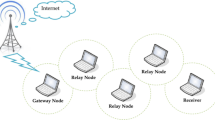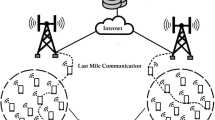Abstract
In order to support high data rate requirements and effectively manage the scarce wireless resources, additional bandwidth channels are allocated and taken away from mobile stations in 3G wireless data networks quite frequently. A TCP sender connected to the mobile, on seeing ACKs coming at a faster pace after additional bandwidth allocation, turns overtly optimistic and injects data into the network at a rate that might be excessive for an intermediate router, thereby leading to loss of multiple packets and subsequent prolonged recovery and periods of underutilization. In this work, we characterize this problem using an analytical model for losses based on continuous flow approximation as well as an extensive simulation setup. We also illustrate how bandwidth oscillations create more severe congestion than an increase in number of users to the extent that even RED algorithm is unable to check the sharp growth of queues. As a result, multiple packets are lost in a droptail fashion. We further demonstrate the dependence of congestion due to bandwidth allocation on the time during which mobiles' rates are increased and observe the degradation in performance for typical load scenarios. We also try to identify the boundary for stable operation of RED and finally present some possible methods for improving the performance.
Similar content being viewed by others
References
[1] P. Bender, P. Black, M. Grob, R. Padovani, N. Sindhushayana, and A. Viterbi, “CDMA/HDR: A Bandwidth Efficient High Speed Wireless Data Service for Nomadic Users”, IEEE Communications Magazine, Vol. 38, No. 7, July, pp. 70–77 2000.
[2] “Proposed 1XTREME Physical Layer Delta Specification”, Source: Nokia, Motorola, LSI Logic, Texas Instruments and Dot Wireless, Contribution to 3GPP2, August 2000.
[3] TIA/EIA/IS-2000.1, “Introduction to cdma2000 Standards for Spread Spectrum Systems”, March 1999.
[4] TIA/EIA/IS-707-A-1, “Data Services Options for Spread Spectrum Systems – Radio Link Protocol Type 3”, December 1999.
[5] 3GPP TS 03.60: Digital Cellular Telecommunications System (Phase 2+), “General Packet Radio Service (GPRS): Service Description, Stage 2”.
[6] S. Floyd and T. Henderson, “The NewReno Modification to TCP's Fast Recovery Algorithm”, RFC 2582, Internet Engineering Task Force, April 1999.
[7] S. Floyd and V. Jacobson, “Random Early Detection Gateways for Congestion Avoidance”, ACM Trans. on Networking(ToN), Vol. 1 No.4, pp. 397–413 August 1993.
[8] S. Floyd, R. Gummadi, and S. Shenker, “Adaptive RED: An Algorithm for Increasing the Robustness of RED's Active Queue Management”, Under Submission, August 1, 2001.
[9] M. Sagfors. R. Ludwig, M. Meyer, and J. Peisa, “Queue Management for TCP Traffic Over 3G links”, In Proc. of IEEE Wireless Communications and Networking Conference(WCNC'03), Mar. 2003.
[10] A. Gurtov and S. Floyd, “Modeling Wireless Links for Transport Protocols”, in ACM Comp. Commm. Review(CCR), to appear.
[11] M. Yavuz and F. Khafizov, “TCP Over Wireless Links with Variable Bandwidth”, In Proc. of Vehicular Technology Conference(VTC'02), Vol. 3, pp Sept. 2002. 1322–1327.
[12] M. Yavuz and F. Khafizov, “Running TCP over IS-2000”, In Proc. of Intl. Conf. on Comm.(ICC'02), Vol. 2, pp. 3444–3448 May 2002.
[13] Y. Wardi and B. Melamed, “Loss Volume in Continuous Flow Models: Fast Simulation and Sensitivity Snalysis”, In Proc. of 8th IEEE Mediterranean Conference on Control and Automation (MED-2000), Patras, Greece, July 17–19, 2000.
[14] B. Melamed. S. Pan, and Y. Wardi, “Hybrid Discrete-Continuous Flow Simulation”, In Proc. of the SPIE Intl. Symp. on Information Technologies and Communication (ITCOM'01), Aug. 2001.
[15] M. Chan and R. Ramjee, “TCP/IP Performance Over 3G Wireless Links with Rate and Delay Variation”, In Proc of 8th Annual International Conference on Mobile Computing and Networking(Mobicom'02), Atlanta, Georgia, USA, 2002.
[16] B. Liu, D. Figueiredo, Y. Guo, J. Kurose, and D. Towsley, “A Study of Networks Simulation Efficiency: Fluid Simulation vs. Packet-Level Simulation”, In Proc. of IEEE Infocom 2001.
[17] V. Misra, W. Gong and D. Towsley, “A Fluid-Based Analysis of a Network of AQM Routers Supporting TCP Flows with an Application to RED”, In Proc. of ACM SIGCOMM'OO, Stockholm, Sweden, September 2000.
[18] W.R. Stevens, TCP/IP Illustrated, Addison Wesley, 1993.
[19] Guido Appenzeller, Isaac Keslassy, and Nick McKeown, “Sizing Router Buffers,” in Proc. of ACM Sigcomm, August 2004.
[20] Online. http://www.sce.carleton.ca/vpaliwal/dist.
[21] Online. http://www.isi.edu/nsnam/ns/.
Author information
Authors and Affiliations
Corresponding author
Additional information
Vikas Paliwal graduated with a Bachelor of Technology degree in Electrical Engineering from IIT (Indian Institute of Technology), Kanpur, India and an M.S. in Systems and Computer Engineering from Carleton University, Ottawa, Canada. He has five years of research and work experience in telecommunications area in a variety of work environments across the globe. During his under-graduation he worked on a research project in micro-electronics area with IMS Research Labs, Hanover, Germany, and developed some innovative algorithms for circuit schematics and layouts. After graduating from IIT, Vikas was the core Engineering and Marketing Consultant for GMG Telecom Consultants India Limited, New Delhi, India, and helped GMG in developing a level of technical expertise in the areas of security systems that resulted in key research projects from firms such as ADT and Honeywell. Later, as part of his Masters research at Carleton University, Ottawa, Canada, Vikas worked on performance analysis of CDMA data networks and queue management techniques that resulted in five research papers in various academic journals/conferences. His Masters research project also attracted the interest of Nortel Networks, Ottawa, Canada, and helped in starting joint research projects in the area of wireless systems simulation, which was of particular interest to Nortel. Vikas then worked with Solana Networks, Ottawa, on network topology detection and on products that improve the performance of mission-critical IP networks and wireless LANs. This was followed by a year of work with Qualcomm, UK, on modem software design and implementation for Qualcomm's 3G chipsets. Currently he works with Qualcomm Inc., San Diego, CA, on physical layer of WCDMA and HSxPA systems. At Qualcomm, he continues his research activities in advanced wireless systems design and implementation by actively participating in various technical forums and conducting several training/discussion sessions on UMTS systems.
Ioannis Lambadaris was born in Thessaloniki, Greece. He received a diploma in Electrical Engineering from the Polytechnic School of the Aristotle University of Thessaloniki in 1984. He was a recipient at a Fulbright Fellowship (1984–1985) for graduate studies in USA. He received a M.Sc. degree in Engineering from Brown University, Providence, RI, USA in 1985 and a Ph.D. degree in Electrical Engineering from the University of Maryland, College Park, MD, USA in 1991. He was employed as a research associate at Concordia University, Montreal, Quebec, Canada, in 1991–1992. Between September 1992 and July 1997 he has been an Assistant Professor in the Department of Systems and Computer Engineering at Carleton University, Ottawa, Ontario, Canada. Currently he is an associate professor in the same department and a member of IEEE. While at Carleton he received the Premier %92\,s Research Excellence Award (2000), and the Carleton University Research Excellence Award (2000–2001) for his research achievements in the area of modeling and performance analysis of computer networks. Professor Lambadaris' interests lie in the area of applied stochastic processes, stochastic control, queuing theory and their application for modeling and performance analysis of computer communication networks. His current research concentrates on quality of service (QoS) control for IP networks, resource allocation in optical networks, and optimal routing and flow control in ad-hoc wireless systems.
Biswajit, a co-founder of Solana Networks, has15 years of experience in the area of data communication. He has worked at Nortel Networks, Bell Northern Research, Tropic Networks and Belair Networks. The primary focus of his work has been in the area of IP networking protocols and architecture. As an Independent Contributor at Nortel Networks, he spearheaded various advance technology programs and R&D projects in IP networking. He worked as a Network Architect with the MPLS team and as a member of the architecture team at Tropic Networks to address complex optical networking issues. He worked as a System Architect on WLAN mesh networking products at BelAir Networks. Dr. Nandy has a PhD in Electrical and Computer Engineering from the University of Waterloo and has been an Adjunct Research Professor with Systems and Computer Engineering at Carleton University since 2001. He holds an M.Tech in Electrical Engineering from Indian Institute of Technology, Kanpur and a B.E. in Electronics and Telecommunication Engineering from Jadavpur University, Calcutta. He has authored and presented over 25 research papers in International conferences and holds 12 US patents. He has actively participated in various Work Groups in IETF and author of several IETF proposals in the form of Internet Drafts and RFC.
Rights and permissions
About this article
Cite this article
Paliwal, V., Larijani, P., Lambadaris, I. et al. Congestion due to Rate Variations in cdma2000 Data Networks. Wireless Pers Commun 38, 391–412 (2006). https://doi.org/10.1007/s11277-006-9049-2
Received:
Accepted:
Published:
Issue Date:
DOI: https://doi.org/10.1007/s11277-006-9049-2




